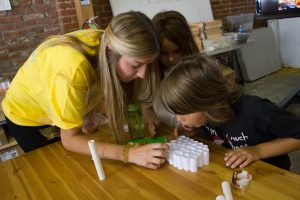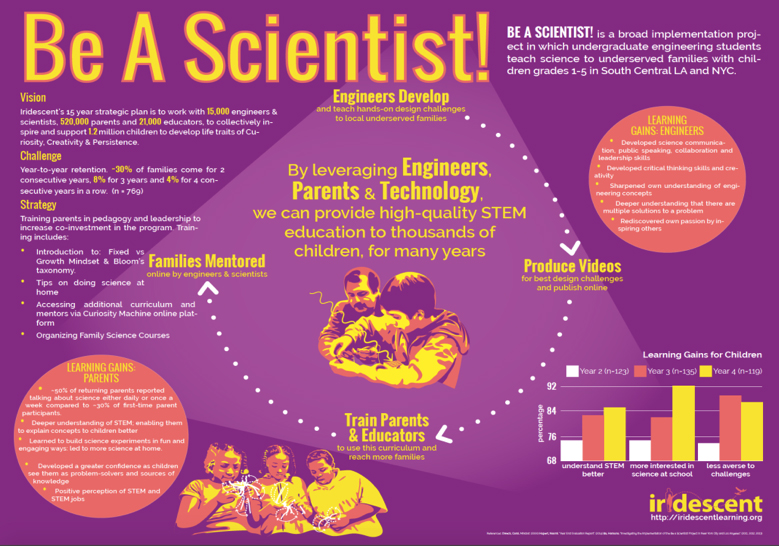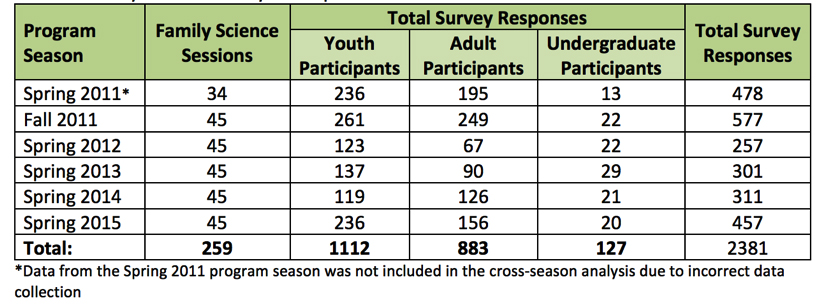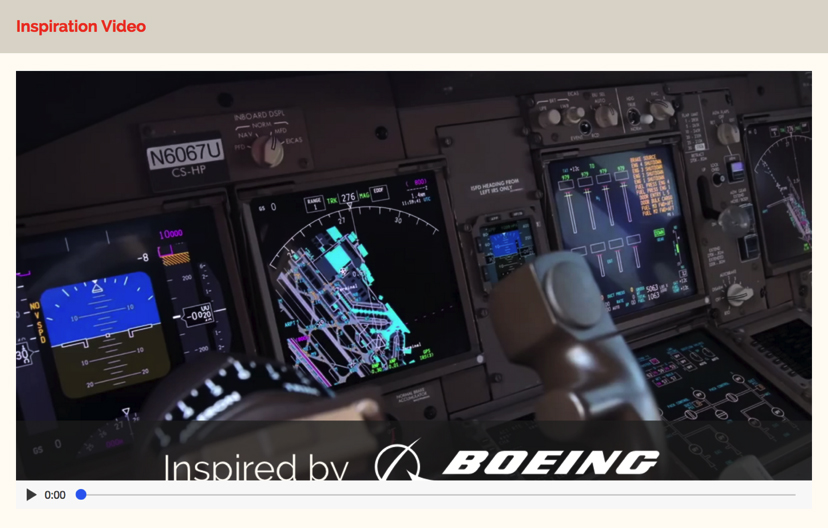Diversity and Equity
Curiosity Machine
Building a Family Program Featuring Collective Impact
Connected Science Learning April-June 2018 (Volume 1, Issue 6)
By Wallace Louie, Tara Chklovski, Maggie Jaris, and Audra Torres
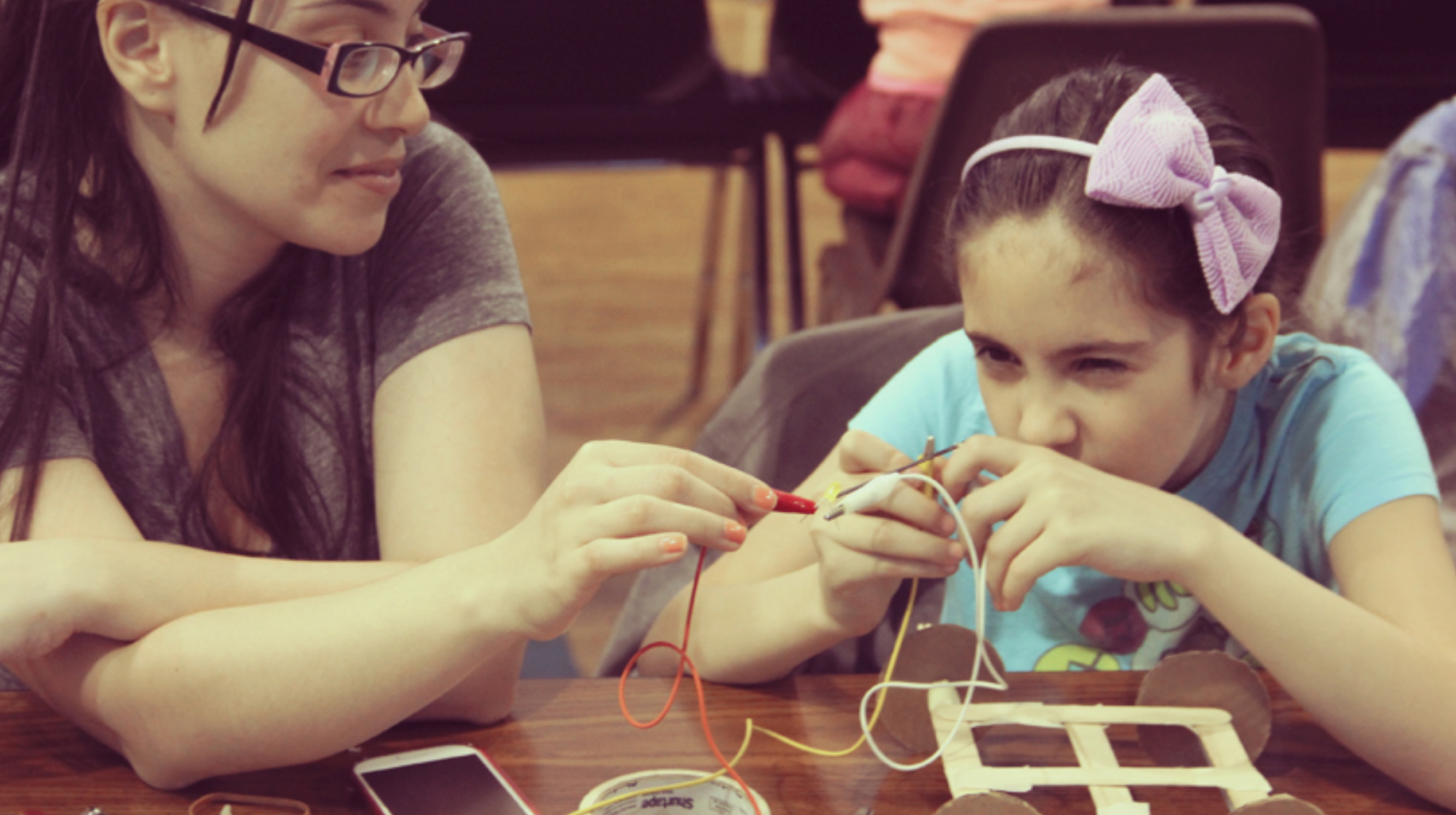
The Curiosity Machine Family Program at Iridescent Learning brings underserved families together over five weeks to do open-ended engineering design challenges with the help of scientists and engineers, who mentor the families as they build.
To welcome the 21st century, the National Academy of Engineering identified 14 Grand Challenges that it believes will define this century and require specific engineering solutions. These challenges were issued as an invitation and guidance for engineers working to build a better tomorrow. I elected to focus on the challenge of advancing personalized learning when I founded Iridescent, my nonprofit. In tackling this challenge, I started a project that became the Curiosity Machine Family Program, which strives to create an exciting learning experience for children, especially those with few resources, at a large scale with low cost and high fidelity. Addressing each of these constraints together is where innovation lies, as most organizations struggle with keeping program costs low, while making sure each implementation is locally reaching the overall program’s goals.
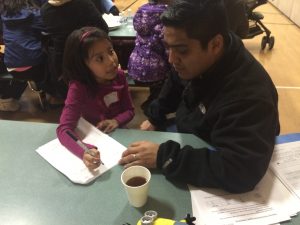
I established the project goal and the design constraints (global scale, low cost, high quality); built a team of engineers, scientists, educators, and innovators; and started Iridescent, a global engineering and technology education nonprofit in 2006. Iridescent’s mission is to empower the world’s under-represented young people, especially girls, through STEM projects so that they have the tools to become inventors and leaders. We ran our first program in Los Angeles in 2006, and 12 years later serve underserved communities throughout the United States and in over 100 countries. From the very start we had a deeply collaborative approach, engaging mentors from industry and academia to provide content knowledge as well as personalized, technical feedback and role modeling for families.
Collective impact can be defined as a demonstrated commitment by a group of critical actors from different sectors to reach a common goal for solving a specific social problem, using a structured form of collaboration (Kania and Kramer 2011); that is, collective impact brings people together in a structured way to achieve social change. In science, technology, engineering, and mathematics (STEM) education, where there are so many actors with different agendas, it is not difficult to see that in many cases, only isolated impact is achieved. Iridescent was founded to discover ways to create sustainable collective impact in STEM education.
As a team, we tried various approaches to develop more personalized learning experiences, collected data, and became more knowledgeable about what worked and did not work with each passing day. We share here what we have learned over the past decade.
Creating a collective impact program: Hypothesis and design principles
Early on, we learned that education is complex, working with people can be messy, and launching an education program (even one that is free to families) on a large scale is challenging. We realized that this was much harder in comparison to developing a widget, an app, or even an airplane. This was because for deep impact, the program needed to be “high dosage”—that is, we were working with children, parents, teachers, and mentors over the course of many months or even years. Over such time scales, human beings change, their interests change, their life situation and goals change. And this made the whole process of long-term impact messier and harder to implement. We constantly learned new things about the communities we worked with, how best to appeal to local industry partners and universities to source mentors, and the on-the-ground challenges the schools faced. These data points influenced our developing model and helped us identify and engage untapped resources and social capital.
For instance, one surprising piece of information we learned was that most people (even those who attend graduate school) spend only 18%–20% of their lives in formal learning environments. The majority of our time is spent in informal, self-directed learning environments. Additionally, parental involvement emerged as a leverage point that strongly impacts academic achievement, social competence, rates of risky adolescent behavior, and success in postsecondary education and careers (Christenson and Sheridan 2001; Henderson and Mapp 2002; Jeynes 2005).
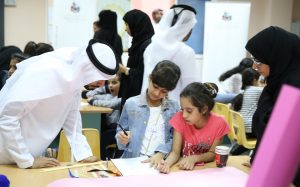
These findings had multiple implications for Iridescent’s model—parents being key influencers in a child’s development would need to play a critical role in our strategy. This did, however raise a challenge: Although STEM fields inspire and excite many people, asking parents to play a role in STEM programs is challenging, due to their discomfort or low confidence in their own STEM proficiency (Peterson 1989; Epstein 1995; Sosa 1997; Rogoff, Turkanis, and Bartlett 2002; Hornby and Lafaele 2011; Zickuhr and Smith 2012; Goodall and Montgomery 2013; Lopez, Gonzalez-Barrera, and Patten 2013; Smith 2014). We understood that our model would have to navigate these gaps in parents’ sense of self-efficacy toward STEM subjects. We hypothesized that:
- We could potentially overcome parents’ knowledge gaps by bringing in STEM experts from corporations and academia into our programs as mentors.
- Developing self-motivated learners takes time, practice, and repeated modeling of the core character traits of curiosity, creativity, and perseverance. Thus, we would have to retain the interest and commitment of STEM experts, educators, and parents who would need to support students over many years. This would be possible if we provided ongoing value to the adults—ideally, something that helped them develop as leaders and innovators (Dierking 1994; Bell 2009).
- We could lower the stakes of failure by providing opportunities for families to practice applying problem-solving skills together in a supportive environment. We could also draw on the Engineering Design Process to demonstrate the importance of design iteration and improving elements that failed or poorly performed.
Viewing these points holistically, we had the skeleton of a collective impact strategy, but we quickly learned that having a strategy is only a small part of the battle. Implementing a collective impact model on the ground is unquestionably hard work.
Our model relied on three very different groups of people: engineers, educators, and parents from underserved communities. Collectively, they were the very essence of a cognitively diverse group, bringing together different languages, nationalities, perspectives, education and socioeconomic levels, heuristics, technological literacies, and learning speeds. Due to the nature of our recruitment, however, although these groups seemed different, they had two very important characteristics in common: (1) an interest in helping children become self-driven learners, and (2) a certain comfort with risk and trying new things. In the case of the parents, this was clearly evidenced in the fact that hundreds attended the family sessions.
Face-to-face learning
Iridescent’s Curiosity Machine Family Program brings underserved families together over five weeks to do open-ended engineering design challenges with the help of scientists and engineers, who mentor the families as they build. Through Curiosity Machine, students learn how to apply the engineering design process and develop their problem-solving skills, with the support of educators, parents, and mentors.
The goals of a Curiosity Machine Family Program are to
- inspire participants with cutting-edge innovations from industry and research,
- build a long-term relationship between two disparate groups: engineers and minority families,
- model the engineering design process and effective strategies for working through failure, and
- introduce the online Curiosity Machine platform as a resource for continued learning at home.
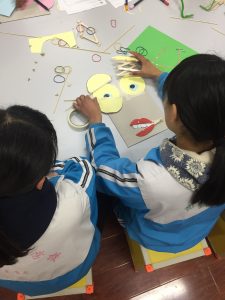
The Curiosity Machine Family Program consists of five two-hour sessions held weekly at a partnering school. Two key logistical elements make this program successful at engaging underserved families in STEM. The first is holding the sessions during dinner time (5–7 p.m.) and providing dinner for the families. This schedule frees families from the responsibility of making dinner, and directs that free time toward fun learning activities. The second element is holding the program at a familiar space— ideally their child’s school, although it is also possible to hold the program at a community center, museum, or library, as the model does not change based on location. In some cases, teachers, teaching aides, and museum educators provide administrative support, food, and general assistance.
The school (or other community site) provides the in-class or afterschool space, parent leaders manage program logistics, and local engineers lead the sessions. Iridescent provides trainings for each stakeholder. Parents who come forward to volunteer and lead, are trained to become leaders in their school community and organize logistics for an ongoing program. Engineers are trained to communicate technical ideas clearly and simply, as well as facilitate hands-on projects with a group of learners varying widely in age, comfort with STEM content, and fluency in English. (See below for more information about training for each of these groups.)
In a typical session, engineers spend the first five minutes of the session briefly introducing their work, and then show a Curiosity Machine Inspiration Video related to their area of expertise. Following the video, engineers introduce a Design Challenge, such as, “Make a structure that can change how waves move, and learn how to make things invisible!” Families learn about metamaterials, tiny nano-size particles that manipulate the way light waves move. They get a more intuitive understanding of this concept by creating a flexible, connected structure that adjusts to water waves so that a deck of cards on top of the structure remains in place.

The families spend an hour planning, designing, building, and testing their design while the engineers walk around the room helping them. After testing and redesign, engineers lead an Analyze and Reflect exercise for participants and encourage them to keep improving their models at home.
Blended learning
Following this community learning experience, families continue to learn by doing additional design challenges at home. They are supported by Iridescent’s online platform, curiositymachine.org, which gives them access to curricula, instructional videos, virtual STEM mentors, and additional resources.
Curiosity Machine blends project-based STEM learning with virtual curricula and mentoring. Students can upload videos of their own projects in response to a design challenge, and virtual mentors can then provide personalized feedback on how best to improve their design.
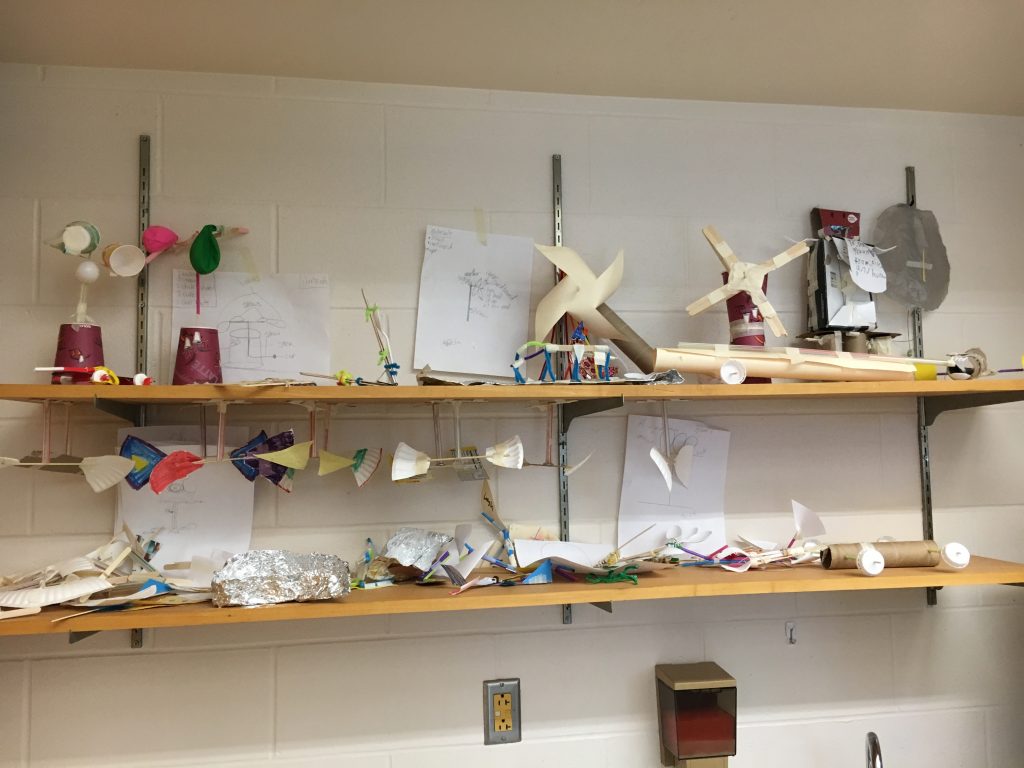
Engineer recruitment and training
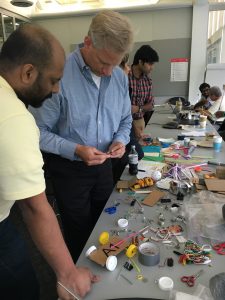
We work with STEM industry and academia to recruit engineers and scientists in two main capacities:
- Content experts: Engineers and scientists are invited to open the “black box” of what they are working on, explain core underlying physics concepts behind their work, and help children walk in their shoes by going through the problem-solving processes used in real engineering work.
- Mentors: Only a few engineers and scientists are featured in the Curiosity Machine videos, but we engage thousands as mentors and role models for the families. Volunteers go through training and then either mentor families in-person through the Curiosity Machine Family Program, or virtually via the Curiosity Machine online platform.
The ideal engineer and scientist for our programs is:
- comfortable with building projects with their hands,
- interested in learning how to build unique designs out of everyday materials,
- willing to learn how to simplify complex concepts for children ,
- able to work independently,
- able to commit 10–15 hours total over a period of three months,
- interested in connecting with the community, and
- open to receiving feedback on ideas.
Engineers interested in becoming STEM mentors go through a technical communication training composed of seven modules that cover the following topics:
- Introducing yourself and your work in simple language
- Interacting with families in a culturally sensitive and warm manner
- The significance and pedagogical importance of open-ended design challenges
- Facilitating the engineering design process with students and parents
- Asking open-ended questions that develop higher-order cognitive traits of curiosity, creativity, and persistence; assessing student learning
- Being aware of stereotypes and gender biases and learning how to address them
- Supporting a growth mindset in participants and in the mentors themselves
Parent training
Parents receive a combination of online and in-person training to establish a vibrant STEM learning community at their school. The first stage of training is conducted in person with parents who have expressed interest in becoming Curiosity Machine Parent Leaders. This five-hour training covers basic physics and pedagogical concepts such as
- fixed mindset (or a belief in innate abilities) versus growth mindset (or a belief that success is a function of hard work) (Dweck 2007);
- learning to identify and address negative attributes, or characteristics or perceptions of parents that impede them from encouraging their children toward STEM (Schunk, Pintrich, and Meese 2008);
- Bloom’s taxonomy and asking open-ended questions (McComas and Abraham); and
- how to encourage and support youth to develop their sense of self-efficacy (Bandura 1997).
The goal of this training is to help parent leaders increase their own sense of self-efficacy and become empowered to train and support other parents in the school community. Through this “train-the-trainer” model, we help build capacity and lay a strong foundation for a STEM learning community.
Parents then learn how to bring Curiosity Machine to their school and run two Family Programs over the course of the year. They take responsibility for recruiting families for the Curiosity Machine Programs, coordinating dinners, managing translations, buying materials for the design challenges, and registering families at each session and onto the online platform.
Program evaluation
The model’s efficacy has been demonstrated through a summative, external evaluation of our five-year, longitudinal, National Science Foundation–funded project Be a Scientist; this evaluation was conducted by Education Development Center’s Center for Children and Technology (EDC|CCT). Over five years, Iridescent ran six Curiosity Machine Family Program implementations (comprised of weekly sessions) in New York and Los Angeles at nine different school and museum sites. The school-based sessions took place in the early evening, whereas sessions at the museums took place on Saturday mornings to allow families to enjoy the museums, free of charge, after the Curiosity Machine program. Iridescent worked with the same schools and museum partners over the five years that were evaluated. In total, Iridescent served 2,173 participants, including children and families, for 18,628 hours over the five years. In addition, teachers, teaching aides, and museum educators participated in program activities.
Timeline
Year by year:
Cumulative:
Methods and instruments
EDC researchers employed a multimethod research approach to data collection that reflected the structure and goals of the program. Researchers developed a set of instruments during the first year of the project to collect feedback (in Spanish and English) from program participants, including children (with parental support), parents and adult family members, engineers, and school staff.
Children were asked questions about their attendance at the Family Program sessions, their interest in STEM-related activities, and impact on their knowledge and behavior since participating in the program. They were also asked to draw a picture of their favorite construction activity.
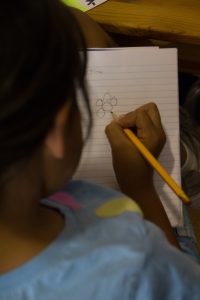
Parents were asked to rate various statements about STEM activities and careers, indicate the frequency with which they engage in STEM activities at home, and answer other questions about their experiences with the Curiosity Machine Family Program.
In addition to surveys, EDC conducted formal and informal interviews with parents and children and focus groups with the engineering university students who served as the mentors in this project. Formal interviews with returning parents and their children were organized and scheduled by Iridescent staff and held over the course of one afternoon at the Iridescent offices. The purpose of these interviews, conducted in both English and Spanish, was to better understand the impacts on families who had participated in this Curiosity Machine Family Program for five years. The interviews included questions about parents’ perceived impact of the program on their family activities in relation to science, their children’s academic performance, and their children’s interests in and outside of school in science and related activities. Parents and students also reflected on their experience in the program and shared challenges and recommendations.
Impact on students and parents
As seen in the table below, a total of 1,112 students and 259 parents completed the surveys over the five years.
Nearly all students said they like studying science in school (92%, N = 211), and three-quarters noted that they asked a lot of questions in school (75%, N = 208). Notably, responses from returning and first-time students varied widely on this question. Eighty-one percent of returning students agreed or somewhat agreed that they asked a lot of questions in school, whereas only 68% of new students agreed with the statement—a statistically significant difference of 13 percentage points (p < 0.05). Students described engaging in scientific thinking practices such as building things (95%, N = 209) and touching things to learn about them (87%, N = 210). Finally, 85% of students agreed or somewhat agreed that they would be a good scientist or engineer someday (N = 208). Researchers also analyzed student responses by gender to see if there were any noticeable differences. The biggest differences in student outcomes came in response to whether they like to touch things to learn about them. Nearly all of the girls in the program agreed or somewhat agreed with this statement (95%), while only 78% of the boys in the program agreed—a difference of 17 percentage points (p < 0.001).
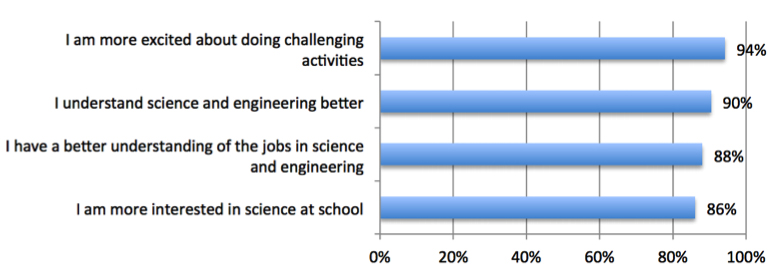

Impact on students’ behavior
The five-time returning students who were interviewed shared similar sentiments. When asked what they want to be when they were older, seven out of eight students mentioned a career in science or engineering; five of those students said their experience with Curiosity Machine had influenced what they want to do. Three students said they want to be scientists, two students want to be doctors, one student wants to be a biomedical engineer, and one student said she wants to be a science teacher. When asked what about the Curiosity Machine program made her want to be a scientist, one student said, “because building stuff is awesome and you could try to use it and try to build something new in the world.”
Students also responded that they were more excited about doing challenging activities (94%, N = 207) and that they were more interested in their science class at school (86%, N = 207). Returning students were slightly more likely to agree with the statement about being excited to do challenging activities, with 98% agreeing or somewhat agreeing, whereas only 91% of first-time students agreed with the statement, a difference of 7 percentage points (p < 0.05). Seven students were asked whether participating in the Curiosity Machine program had helped them do better in school. All seven students agreed that participation in the program had indeed helped them in school. Two students talked about learning relevant content about circuits and energy that they could apply in their classrooms. One student said he was getting better grades and another girl got extra credit for sharing her Curiosity Machine projects with her teacher. One fifth-grade girl talked about how Curiosity Machine helped her think like a scientist at school: “When we build something and it’s not made correctly, we have to keep on trying to get it [right,] because you have to have patience to do it. And my teacher says that scientists don’t build things [in] one try. They take many tries to build it.”
One mother said, “[My child has] done better projects at school because she participated in the Family Science Program. The program gives her ideas that she didn’t have before. For example … she understood [electricity] better in school because she was participating in Curiosity Machine.” Another mother talked about her son being more patient and independent: “When he was younger, it seemed he would always get anxious and hyper and rush his work and wouldn’t grasp the ideas. Now he tries to do it a bit better. And now he doesn’t need me to help him; he does it by himself.”
Parents who attended Family Science sessions for five consecutive years shared what they enjoyed most about coming to the programs. Overall, parents liked being able to do something together as a family.
One mother talked generally about doing more activities together: “I see we’re [closer] together than before because of the times that we spent together. So, now we try to do more [stuff together] at home and not just the projects—like any other stuff—but we always try to do it together.”
Parents also liked watching their children working through challenging projects. A mother of fifth-grade twin girls shared that what she enjoyed most about attending Curiosity Machine was “seeing their faces when they learn something new or whenever they see something that interests them … seeing them try and whenever they get something wrong, they don’t cry or they don’t [make a] … sad face. They’re like, ‘Oh, let’s try it again; let’s do it again. We have to do this.’”
Similar sentiments were expressed by new participants who had participated for two years or less. For parents, fostering their child’s interest in science is a top priority, and they feel that a program such as Curiosity Machine helps children learn new ways of understanding the world.
Parents also liked that their children were learning from, getting firsthand experience building things with, and getting feedback from real engineers. One mother at the New York Hall of Science felt that “It is important for our kids to be exposed to things they don’t normally experience in school.” Another mother at Synergy Charter Academy said, “It gives my kids an activity to do rather than them being at home watching TV. This program helps them exercise their minds.”
Overwhelmingly, parents and guardians reported positive changes in their own behavior since participating in the Curiosity Machine programs. Over 90% of all respondents (N = 148) agreed or strongly agreed that since participating, they would engage in more science-related activities such as visiting zoos, reading books about science, watching science-related TV shows, and doing hands-on science activities at home. Similarly, 94% indicated that they would ask their child more questions about science class, and 91% said they would encourage their child to pursue an education or career in science or engineering.
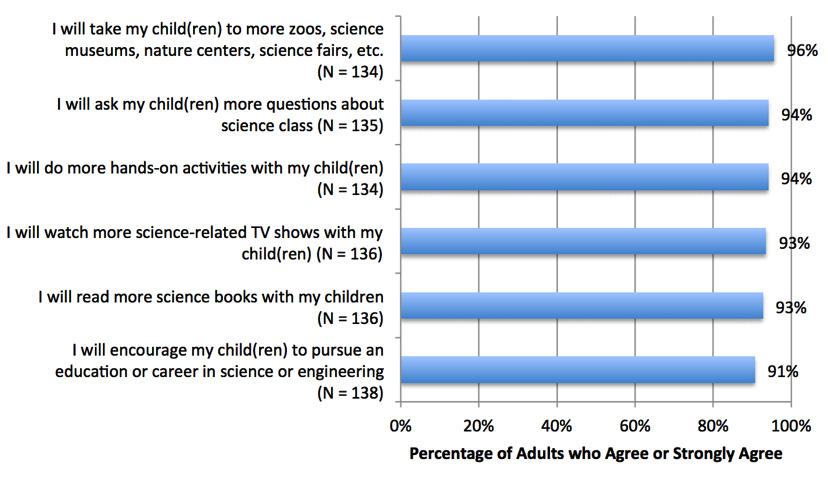
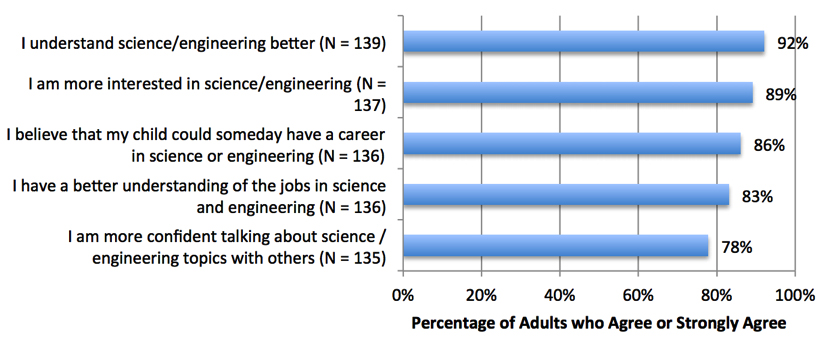
Impact on mentors
An overwhelming majority of the mentoring undergraduate engineering students (N = 20) reported having a positive experience teaching and mentoring the families. Eighty percent of the engineering students described the experience as “a great opportunity to learn outside the usual classroom,” “a good break from typical engineering classes,” and “fun and challenging in a way engineers typically aren’t exposed to.”
The undergraduates appreciated that the experience allowed them to gain teaching skills and confidence in explaining what they do. Specifically, student engineers summarized the impact on their skills and interests in the following ways:
- Improved communication skills: “I’ve gained a better understanding of how to work with people of different backgrounds and to communicate difficult subjects in a more effective manner.” —senior in mechanical engineering
- Better understanding of teaching practices: “I gained an understanding of what it takes to get children excited about learning STEM. It takes an entirely different approach than teaching adults; otherwise, [the children’s] attention is lost.” —junior in mechanical engineering
- Increased knowledge of the local community: “I learned a lot about the community around USC [University of Southern California]. The school kids need a lot of motivation to get into science and engineering. They need to realize that science is not merely solving problems on paper, but [that] it involves thinking about creative solutions to complex, real problems.” —junior in physics
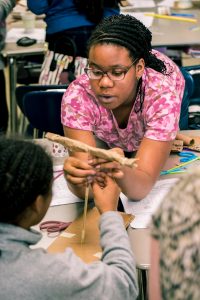
The undergraduate engineering students were asked to rate to what extent they agreed with a number of statements about their experience. Nearly all of the engineers (80%) reported that since participating in this implementation of the Curiosity Machine Family Program, they feel more comfortable managing a classroom of students and more proficient working with children. Three-quarters of the student engineers (75%) reported improved communication skills, specifically public speaking and communicating complex science ideas to nonscientist audiences (Pierson, Momoh, and Hupert 2015).
Two of the initial design constraints of our model were that it should be scalable and low cost. We hypothesized that technology would be a key enabler for reducing implementation costs. For example, if we could determine the elements of mentorship that are most effective in changing attitudes, then we could try to recreate those elements in a virtual environment, allowing mentors to reduce commuting time and reach more students.
We began by testing different versions of our in-person programs across multiple regions to ensure that it was easily adaptable. Once we were confident that stakeholders would be able to adjust the program model to fit their needs, we slowly started swapping out in-person pieces of the model with elements of technology, such as the process of mentor feedback, and refining these elements.
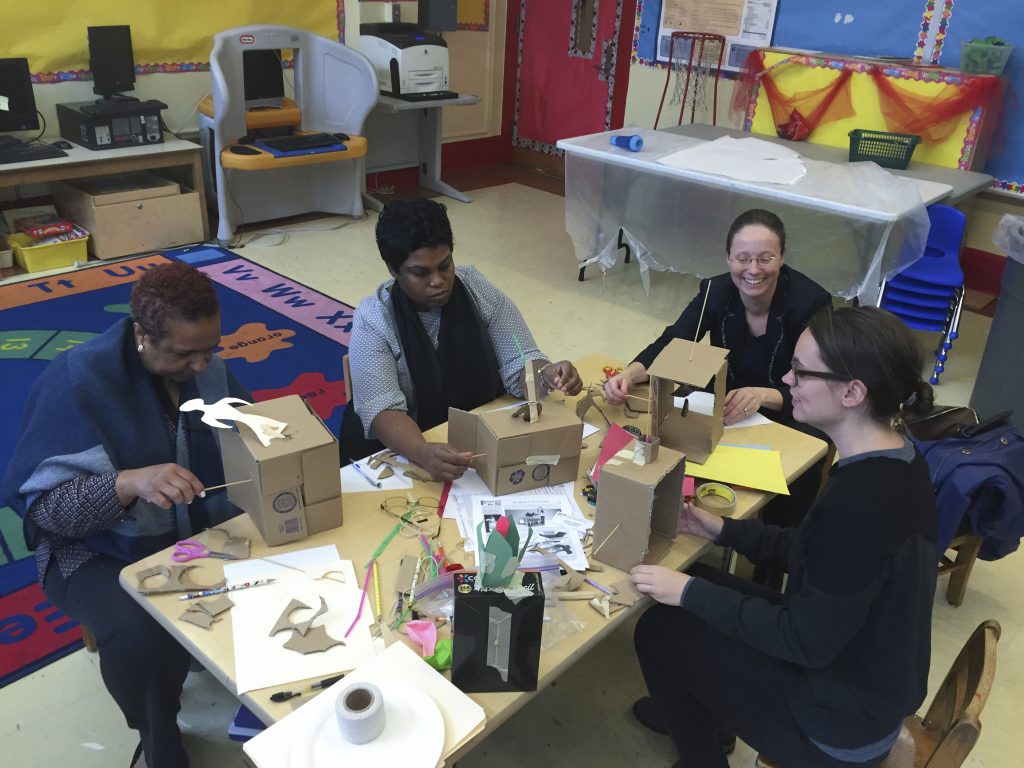
Implementation
Over the past two years, we have had the opportunity to roll out our collective impact model in a more deliberate manner in partnership with major engineering corporations. With each partnership, we trained engineers and community partners to come together and engage children in exciting, open-ended engineering design challenges over many weeks. The following case study of our partnership with Boeing illustrates the adaptability of our collective impact model and highlights some of the lessons we’ve learned in building this partnership.
In winter 2014, Iridescent partnered with Boeing and the Washington Alliance for Better Schools (WABS) in the Puget Sound area of Washington state. Boeing was seeking skills-based volunteer opportunities for its employees and opportunities to deepen its long-standing relationship with WABS.[1] WABS is a nonprofit that works to involve parents in their children’s education. Through WABS programming and training, parents begin taking leading roles in education settings and often find employment at their children’s schools or become leaders in their communities. Most of the parents WABS works with are immigrants who are learning English as a second language and do not have high school or college diplomas. WABS encourages parents to pursue further education for themselves. Given the schools and parents WABS works with, and its built-in support network for parents, it was an ideal partner for this implementation.
The implementation had three stages, with evolving roles for each partner.
Stage 1: Winter 2014 and spring 2015
The implementation began with one school in the WABS network. Iridescent focused on training Boeing engineers to lead Curiosity Machine Family Courses and parents to support these sessions. Iridescent trained Boeing engineers to develop design challenges based on their work and teach the content behind these design challenges at the school. Iridescent also trained parents to support the engineers by managing the logistics of the course. During this stage, Iridescent provided over 60 hours of support to each engineer, and the program reached approximately 120 students and parents.
Example: Design Challenge (DC) developed by Boeing Engineers
During Stage One, Iridescent worked closely with Boeing engineers to support them in developing Design Challenges based on their work. Two Boeing engineers that we trained, Jackie and Sarah, work on preventing hackers from accessing planes’ computers and develop alarm system networks to notify Boeing of any intrusions. This work is highly conceptual, but Jackie and Sarah were able to take these concepts and develop a hands-on project that would engage learners of all ages. Through the Hack a Box challenge, students were asked to build an alarm system that indicates when someone is trying to access the box being protected.
Boeing conducted a preliminary internal study evaluating the impact of Iridescent’s model on 26 of their engineers. Eighty-two percent of participating engineers said that developing and teaching the engineering design challenges increased their own creativity and communication skills (Richey et al. 2015).
Stage 2: Fall 2015
In fall 2015, Stage 2 of the implementation began. This stage focused on training parents to present and facilitate the design challenges. Iridescent trained approximately 60 parents at two different schools in the WABS network.
Parents now played the primary role in recruiting parents, supporting the logistics of materials, and teaching and leading Curiosity Machine Family Courses, whereas engineers took on a supporting role, working with families during the building stage of each session.
Iridescent led a full-day training with parents that covered how to teach and present design challenges. We learned that this one-day training was not sufficient for building parents’ confidence in themselves, so for Stage 3, we added a series of webinars where parents would build a design challenge over a video call and receive immediate feedback from Iridescent staff. Engineers from Boeing were also trained to provide support during the virtual parent sessions, and many of the engineer volunteers from Stage 1 continued to volunteer in Stage 2.
Through Stage 2, approximately 120 students and family members were reached.
Stage 3: Spring 2016
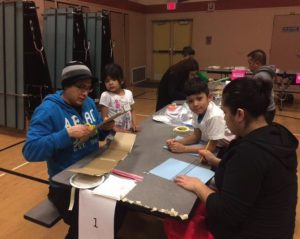
Stage 3 focused on scaling the implementation and transitioning the responsibility for parent training and support to WABS rather than Iridescent. Iridescent trained 25 parents from 10 different schools, improving the training based on the feedback received during Stage 2. Notably, this included adding additional parent training webinars throughout the year. During these webinars, parents would create a design challenge and receive immediate feedback and support from Iridescent staff via videoconferencing tools. Parents also practiced delivering their content-focused presentations and received individual feedback from Iridescent staff. These webinars were still a high-touch method of support, and over the course of the implementation, parents developed their confidence and became more comfortable in the role of facilitators and leaders.
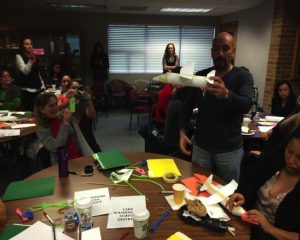 We also made recommendations for organizing parent leaders, suggesting that schools select one parent leader to teach the STEM content and assign two parent leaders to facilitate the building sessions and manage logistics. Moving forward, additional support will come from WABS staff members who are familiar with the implementation model and the parent trainings and support.
We also made recommendations for organizing parent leaders, suggesting that schools select one parent leader to teach the STEM content and assign two parent leaders to facilitate the building sessions and manage logistics. Moving forward, additional support will come from WABS staff members who are familiar with the implementation model and the parent trainings and support.
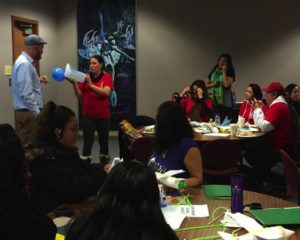
Stage 3 is remarkable because it fully transferred leadership responsibilities to parents and transitioned support roles to WABS staff. Iridescent has been able to pull back its support and allow the program partners to continue to expand their comfort zones.
Over the course of the implementation, approximately 500 children and 300 parents participated in Curiosity Machine Family Course programming at WABS schools.
Insights and lessons from 10 years exploring collective impact
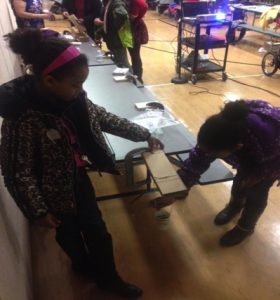 In 10 years of developing and adapting a collective impact model that can work with large school networks and in small communities, we learned some surprising things about STEM education:
In 10 years of developing and adapting a collective impact model that can work with large school networks and in small communities, we learned some surprising things about STEM education:
- Collective impact models bring together very different groups of people, and we quickly realized that we needed to do significant training for each group on how to communicate effectively. Our trainings had to cover communicating with children and adults from different backgrounds. This meant that trainings had to cover ideas such as open-ended questions and fostering growth mindsets, as well as ideas such as empathy, tolerance, and bias.
- Engineers and scientists (especially those from corporations) typically do not interact with underserved communities or share technical elements of their work with guardians of children. Similarly, guardians from underserved communities do not usually interact with engineers and scientists in a social setting. We learned that we needed to prepare all stakeholders to talk to and connect with one another, and built this into our trainings. We allowed extra time for the groups to meet each other before they started the training and had them go through ice-breaker activities together.
- Such interactions are outside every stakeholder’s comfort zone (engineers, teachers, and parents alike). Each group is learning something new. Parents learn to do open-ended engineering design challenges with their children. Engineers learn how to communicate technical aspects of their work to a public audience in a 10-minute time span. Educators become comfortable with viewing parents as partners in supporting a child’s intellectual development. It was important for us to recognize this, acknowledge this discomfort in our trainings, and allow time for people to adjust.
- Underserved parents are motivated and willing to access opportunities for high-quality education for their children. It is critical, however, to address basic logistical barriers by providing dinner at the evening Curiosity Machine Family Program sessions, holding the sessions at familiar places, translating the content of the presentation and instructions for the activities, providing tutorials for using technology, and ensuring the materials used in the design challenges are low cost.
- On a logistical level, we learned that it is important for each group to have a point person representing it and meeting regularly with the other points of contact for planning out the details of the program.
- We also learned that it takes a long time to successfully implement a collective impact model. For example, our implementation with WABS and Boeing took three years. During the first year, everyone got to know each other and experience the value of this program. The second year was focused on capacity building and helping each group develop its self-efficacy and leadership skills by running more of the program without Iridescent’s help. Finally, the third year focused primarily on getting each group comfortable with using online technologies, through which they could access further content, training, and analytics.
- An unexpected consequence of the three-year time frame was the awkward conversations related to funding and resources that arose in year 2 of the implementation. For each of our partnerships, we did not know how long it would take to change the mindsets of each group, and as a result, we did not plan for continued support and training in years 2 and 3.
- Our strong recommendation to others working on similar collective impact models in STEM is to convene and plan what the program looks like in year 2 and 3, whose roles will change and in what manner, and where the funding for the program will be coming from. Because our model is about building capacity and training partners to lead the implementation themselves (instead of relying on us), the program costs decrease by almost 70% in later stages. Despite the cost reduction, however, there must be an upfront conversation about how the remaining costs will be covered and by whom.
- Finally, although we were not always able to execute this aspect, we saw the long-lasting effects of documenting and disseminating of results whenever we were able. We learned that it is important to have a Celebration of Learning event (with music and food) at the school, that brings the whole community together to celebrate the collective effort. The social, emotional, and physiological elements of this community celebration are critical to helping the program grow and thrive into the next year. It is also important to have a dedicated person taking good photographs and documenting the stories of impact so that these can be shared with the local press and each group’s dissemination channels. This type of impact reporting provides positive feedback to the collective, which motivates them to continue investing time and effort in the multiyear project.
Wallace Louie (wallace@iridescentlearning.org) is senior director of communications at Iridescent Learning in Danville, California. Tara Chklovski (tara@iridescentlearning.org) is CEO and founder at Iridescent Learning in San Carlos, California. Maggie Jaris (maggie@iridescentlearning.org) is communications manager at Iridescent Learning in Chicago, Illinois. Audra Torres (audra@iridescentlearning.org) is designer and manager at Iridescent Learning in Orlando, Florida.



